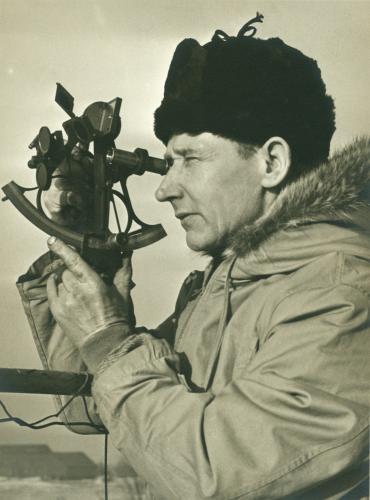(1893–1962) Toronto Centre member; a prominent observer of his day; first Chant Medal recipient.
 BERTRAM J. TOPHAM (1893-1962) was the first winner of the Chant Medal. He was born in England and trained there as a machinist and electrician but emigrated early in his life. He spent five years as an artillery-man with the Canadian forces in France, 1914-19, and was awarded the DCM in 1916. A shell explosion rendered him almost completely deaf for the rest of his life. Though Bert Topham knew nothing of planets or astronomy at the time, he recalled standing in the trenches and watching a bright "star" moving week by week past fainter stars. He even anticipated its return the following winter. On returning to Toronto after the war, he obtained a copy of the Observer's Handbook and concluded that he had been watching Jupiter. This was the start of his fascination with astronomy.
BERTRAM J. TOPHAM (1893-1962) was the first winner of the Chant Medal. He was born in England and trained there as a machinist and electrician but emigrated early in his life. He spent five years as an artillery-man with the Canadian forces in France, 1914-19, and was awarded the DCM in 1916. A shell explosion rendered him almost completely deaf for the rest of his life. Though Bert Topham knew nothing of planets or astronomy at the time, he recalled standing in the trenches and watching a bright "star" moving week by week past fainter stars. He even anticipated its return the following winter. On returning to Toronto after the war, he obtained a copy of the Observer's Handbook and concluded that he had been watching Jupiter. This was the start of his fascination with astronomy.
By the late 1930s he built a large observatory behind his home in what was then known as Fairbank, a suburb of Toronto. With his 16.5 cm refractor¹, he observed rather faint variable stars and was commended by Leon Campbell of the AAVSO for his very precise magnitude estimates. He also systematically searched for novae and comets. On moonlit nights he ground and polished telescope mirrors and welcomed visitors to his observatory. Word of mouth alone attracted thousands of people to his Castlefield Avenue home over the years. According to Dr. Gartlein of Cornell University, Topham was among the most assiduous auroral observers on the continent, and Dr. Millman praised him for his outstanding contributions to meteor research. Severe electrical burns sustained in 1945 sadly restricted his work thereafter. Bert Topham's name is perpetuated in an award for outstanding observers established by the Toronto Centre in 1984.
—Peter Broughton (from Looking Up)
A Life-Changing Accident
In a letter dated 1944 September 15, Topham writes that a work accident "...cooked both hands for eleven minutes while I hung on to two 550V overhead cables when [the] ladder moved." Topham says that he had just completed a four-month stay in the hospital, which would put his accident sometime in early May. This is borne out by the AAVSO International Database where regular variable star observations occur up to JD 2,431,209.5 (April 29) followed by a 321-day hiatus. "I have not [the] power in [my] hands to open my Observatory Dome so [I] will not be able to do telescopic observing until after the final grafting of [my] hands, but, I will do all I can on auroral work..." This would certainly account for the gap.
He may not have ever fully recovered from his injury ("...the burnt tendons of two fingers of [my] left hand make [the] 3rd & 4th fingers useless..."), yet he did continue to do some observing and photography for the rest of his life. In fact, he resumed observing variable stars 11 months after the accident with increasing annual output until 1947 when he appears to have stopped for good.—WM
Variable Star Observing
Year: Obs.
1947: 276
1946: 124
1945: 109
1944: 49
1943: 331
1942: 347
1941: 477
1940: 788
1939: 601
1938: 66
1937: 73
Bert Topham's AAVSO observer code is TP. AAVSO data² shows that he contributed 3,241 observations from 1937 April 17 to 1947 November 21. His annual output is shown at left. In 1944 he suffered a serious accident and eventually stopped observing variable stars in late 1947, just as he was coming close to recovering his pre-accident level of productivity. (Topham's AAVSO observations can also be found in this logbook.) —WM
Bert Topham built the entire structure of his Castlefield Observatory and the gleaming white dome dominated for decades the Dufferin Street district on the borders of North York and York Townships. He equipped it with the latest instrumentation and carried out planned programmes of astronomical study. In the 1940's, both he and his observatory became known to many scientists throughout the continent.
An endearing feature of his makeup was that he liked to share his knowledge and observatory with others, and, quiet frequently, groups of youngsters and adults were invited to attend observing sessions. Mr Topham, who studied both the skies at night and sunspots during the daytime, explained, "I lost my hearing in the last war and I took up astronomy to relieve my sense of loneliness."
—from the centennial edition of 'Scope.
Notes
¹ This telescope was sold to the RASC Montreal Centre in 1957 and was housed in the observatory there. [ref]
² https://apps.aavso.org/webobs/search/, accessed 2019 Aug 7.
Further Reading
- The Chant Medal—First Award to Bertram J. Topham, JRASC (March 1941)
This article details the founding of the Chant Medal and then presents the many reasons for awarding the first to Bert Topham (includes information on his observing activities and other astronomical endeavours). - Castlefield Observatory, Encylopedia Uranica.
- Bertram John Topham, by Lynn Kirk (PDF, from RASC Archives alphabetical files).
A biography, family portrait, and personal recollections of Bert Topham.




